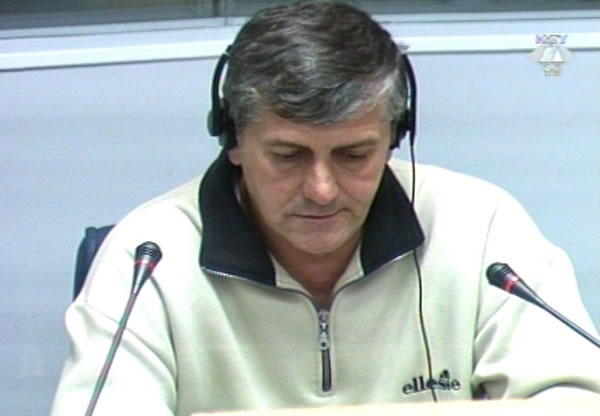Home
A SUSPECT SPEAKS OUT
Although the prosecutor warned Krsto Simic that as a suspect he had the right to remain silent, he decided to speak out about what he did eight and a half years ago in the Srebrenica area.
 Krsto Simic, witness at the Vidoje Blagojevic and Dragan Jokic trial
Krsto Simic, witness at the Vidoje Blagojevic and Dragan Jokic trial Krsto Simic, truck driver and construction machinery operator from Bratunac in eastern Bosnia, waived the protective measures granted to him by the court to testify at the trial of Vidoje Blagojevic and Dragan Jokic, former VRS officers charged with genocide in Srebrenica in July 1995. Although he is being treated as a suspect by the Office of the Prosecutor, Simic also waived his right to testify in the presence of his legal counsel. Just before he began his testimony, the prosecutor warned him once again that he had the right to refuse to answer his questions, but Simic waived that right, too.
In July 1995, Krsto Simic took part in the loading of several hundred bodies of Bosniaks killed in the warehouse of the co-op in Kravica, as well as their transportation and burial in a mass grave in Glogova. Several months later, in the fall of 1995, he took part in an operation to destroy the evidence of the crime: the transfer of the remains from the mass grave in Glogova, which was exhumed, and their re-burial in a so-called secondary grave at Zeleni Jadar, also in the Srebrenica region.
Simic described how on 15 July 1995, the military police came to the company where he worked and ordered him and another driver to report to the command of the Bratunac brigade with their trucks. At that time, the commander of the Bratunac brigade was the accused Vidoje Blagojevic. At headquarters, they were met by Momir Nikolic, chief of security of the Bratunac brigade. Last year he pled guilty for the crimes in Srebrenica and was sentenced to 27 years in prison. He ordered them to go to Kravica, together with several other drivers and their trucks. They went there in a column, escorted by the military police and Momir Nikolic himself.
In the compound of the co-op, they found soldiers and Civilian Protection workers and two machines – a loader and an excavator. Since the machines could not get into the warehouse where the massacre was carried out, Civilian Protection workers dragged the bodies to the door and threw them into the shovel of the loader, which in turn carried them to the trucks. At one point, the loader operator got sick and Momir Nikolic ordered Simic to replace him. For a time he then loaded bodies onto the trucks. The loading process, the witness said, lasted about two hours, and then the trucks drove to the village of Glogova in a column escorted by military police. In Glogova they turned from the main road onto a macadam one and went to the mass grave that had already been prepared. It was about 50 meters long and about 2 meters deep. An aerial photograph taken on 17 July 1995, supplied to the Tribunal by the American government, depicts freshly dug soil on the location identified today by the witness as a mass grave.
Several months later, the witness was summoned again to the Bratunac brigade command with his truck. This time it was for a secret operation to transfer the bodies from primary to secondary graves. The grave in Glogova was dug out with an excavator and the loader loaded the human remains, mingled with soil, onto trucks. This took about two hours and then the column of trucks, escorted by military police, headed towards Zeleni Jadar, where a freshly dug secondary grave awaited them.
On his return from both "missions," the witness explained, they stopped at the parking lot of a local transport company – located about one kilometer away from the Bratunac brigade command – where a water tank truck waited for them. There they washed their truck and then, Simic said, the drivers "went home … to bed."
More than eight years have passed since then, and in all that time, as Simic said in his response to a question by the prosecutor, no one from the military or civilian police in the Republika Srpska has ever asked him what he was doing in the Srebrenica area in the summer and fall of 1995. No one, until an investigator of the Office of the Prosecutor knocked on his door a couple of weeks ago. Krsto Simic agreed to talk to him in Bratunac and then to repeat what he told him in The Hague, regardless of the risk inherent in the status of a suspect.
